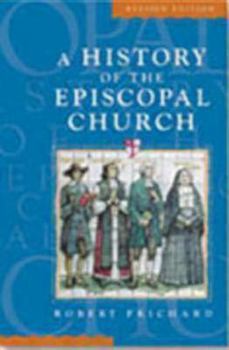A History of the Episcopal Church Revised Edition
Select Format
Select Condition 
Book Overview
This insightful, all-encompassing chronicle spanning 400 years traces the fascinating rise of the Episcopal Church, founded in an age of fragmentation and molded by the powerful movements of American history: the Great Awakening; the American Revolution; the Civil War; two World Wars and the Depression; and the social upheavals of the post World War II years. This revised edition of the now-classic text on the Episcopal Church brings the story up-to-date...
Format:Paperback
Language:English
ISBN:0819218286
ISBN13:9780819218285
Release Date:August 1999
Publisher:Morehouse Publishing
Length:416 Pages
Weight:1.13 lbs.
Dimensions:0.9" x 6.0" x 9.0"
Customer Reviews
4 ratings
Informative
Published by Thriftbooks.com User , 17 years ago
I found this to be a very good summary and overview of the history of the Episcopal Church. I learned more about how the church was formed and developed than from other history books of the Episcopal Church.
great book
Published by Thriftbooks.com User , 19 years ago
A great look at the history of the Episcopal Church, and one that provides the basis for delving deeper. I was handed this by my rector when I asked about the history of our church. Not too many years later, I found myself in seminary, on my way to becoming a priest. Add to that, my instructor was the author of this book!
A good introduction
Published by Thriftbooks.com User , 20 years ago
Robert Prichard's `History of the Episcopal Church' is one of the more accessible of church histories available on the official Anglican version of the church in the United States - the Episcopal Church, sometimes called ECUSA, whose official name, the Protestant Episcopal Church of the United States of America, is a bit of a tongue-twister. Despite the fact that many people came to the Americas for religious freedom (and one of the churches against which they were rebelling was the Anglican church), the Anglican church arrived on American shores very early, with the establishment of colonies on the southern coast of North America (Virginia, the Carolinas), which had official sanction by the Royal authority, and thus official ties to the official church. However, this was a strange situation for Anglicans to find themselves in - while still the official state religion and dominant group back home, they were outnumbered by other immigrants to North America by a significant margin, and this did not even count the numbers of Native Americans. Continuing immigration from non-Anglican parts of the British Isles (Scotland, Ireland, and non-Anglican English and Welsh) caused religious ambiguity in colonial social life and governance also in the New England settlements, which had prior Dutch Calvinist colonies already.Prichard traces this beginning through the Great Awakening, which had Anglicans experiencing internal difficulties, and the Revolutionary War period, where many Anglicans were viewed with suspicion for their ties to the Royalist cause. One of the difficulties caused for Anglicans in America by the Revolutionary War was a suspension of formal ties to the Church of England, where bishops had to swear allegiance to the crown, something the newly independent Americans were not willing or able to do. The consecration of Seabury took place therefore under the auspices of the Anglican church in Scotland, who required as covenant for their transference of episcopal orders the acceptance by the new institution in America of certain liturgical forms, such as the prayer of consecration from 1549 rather than the more common 1552. This also represented the period of the growth of Methodism, with the figure of John Wesley prominent in the activity - Prichard states that while the Methodist movement grew out of and had respect for the Anglican traditions and institution, the only Anglican clergyman whose authority they accepted over themselves was that of John Wesley. Prichard's discussion of the strands that came from earliest Anglicanism is interesting for the future development of various denominations in America, and shows how much common lineage the Christian community in America shares. Prichard's text continues with discussion of the mission and expansion period of American growth, the Civil War period, the settlement of the West and looking toward foreign missions, the Depression and War periods, and finally the second half of the twentiet
An excellent introduction and handy reference
Published by Thriftbooks.com User , 24 years ago
This book is a revised edition of Prichard's work originally published in 1991. According to its preface, the author particularly rewrote the tenth and eleventh chapters, adding sections discussing the development of the Episcopal Church in the last decade of the twentieth century. This update helped me enormously to understand the current situation of the Church as I read it just before the General Convention that the Episcopal Church held in Denver, Colorado, this summer.This book is very readable. It contains many illustrations, which are quite helpful. Compared to David L. Holmes' _A Brief History of the Episcopal Church_ (1993), Prichard narrates the history mostly chronologically and not thematically. He discusses different theological trends that existed in the Church, and follows their interactions and developments. He talks of the changes in women's status in the Church. He neither leaves out the Church's works among ethnic minorities nor foreign missions. The author touches many other historical events as well as important figures. These facts makes the book an excellent introduction and handy reference to the history of the Episcopal Church.






